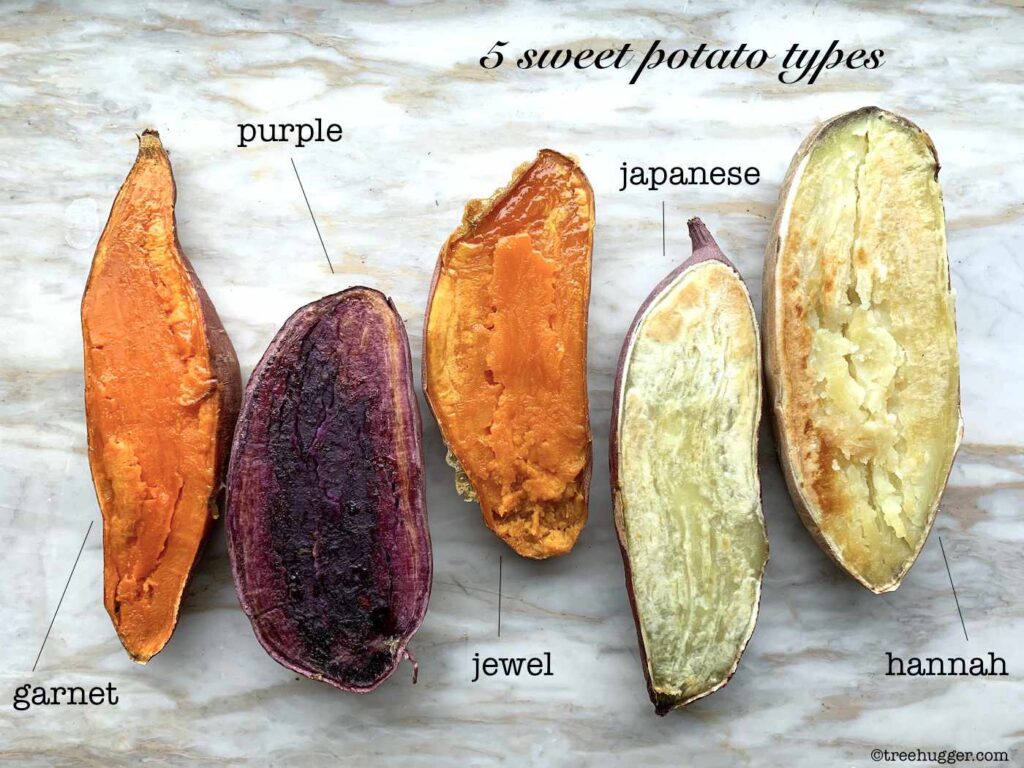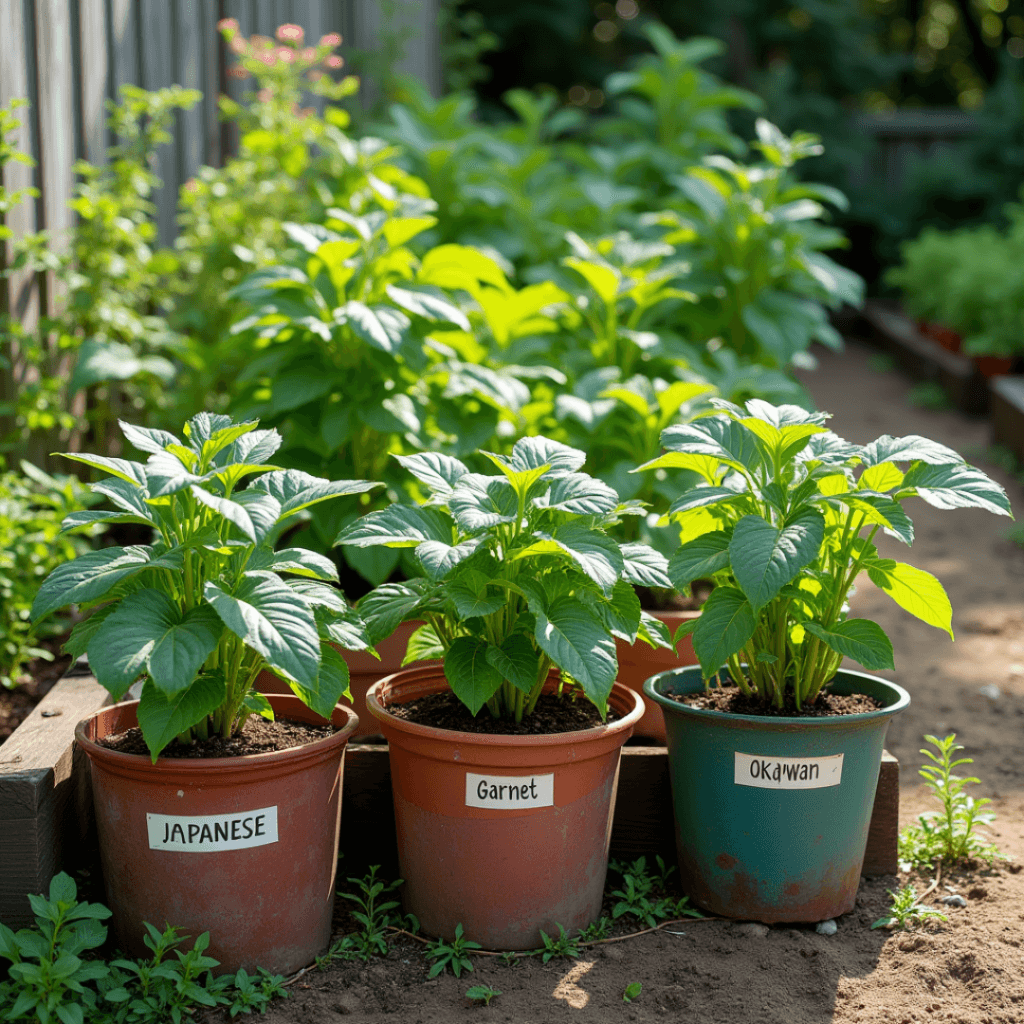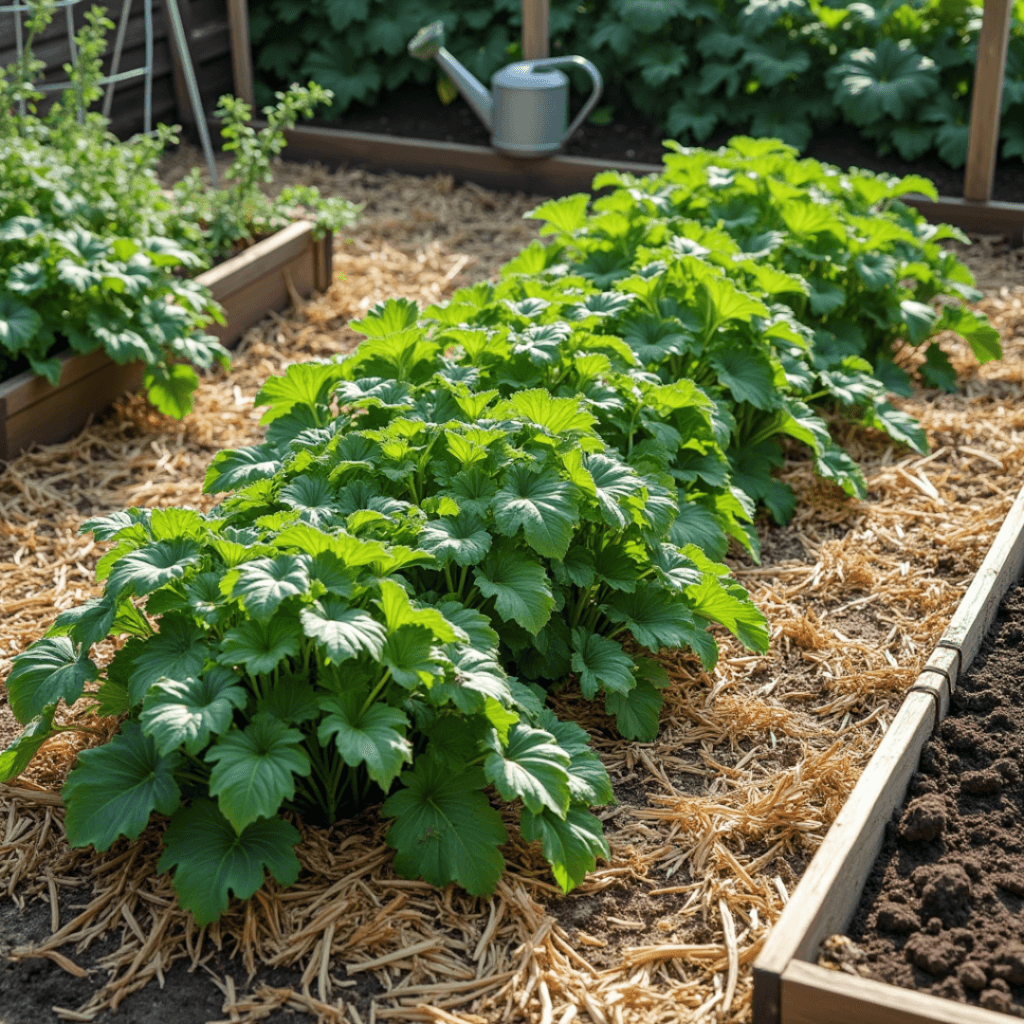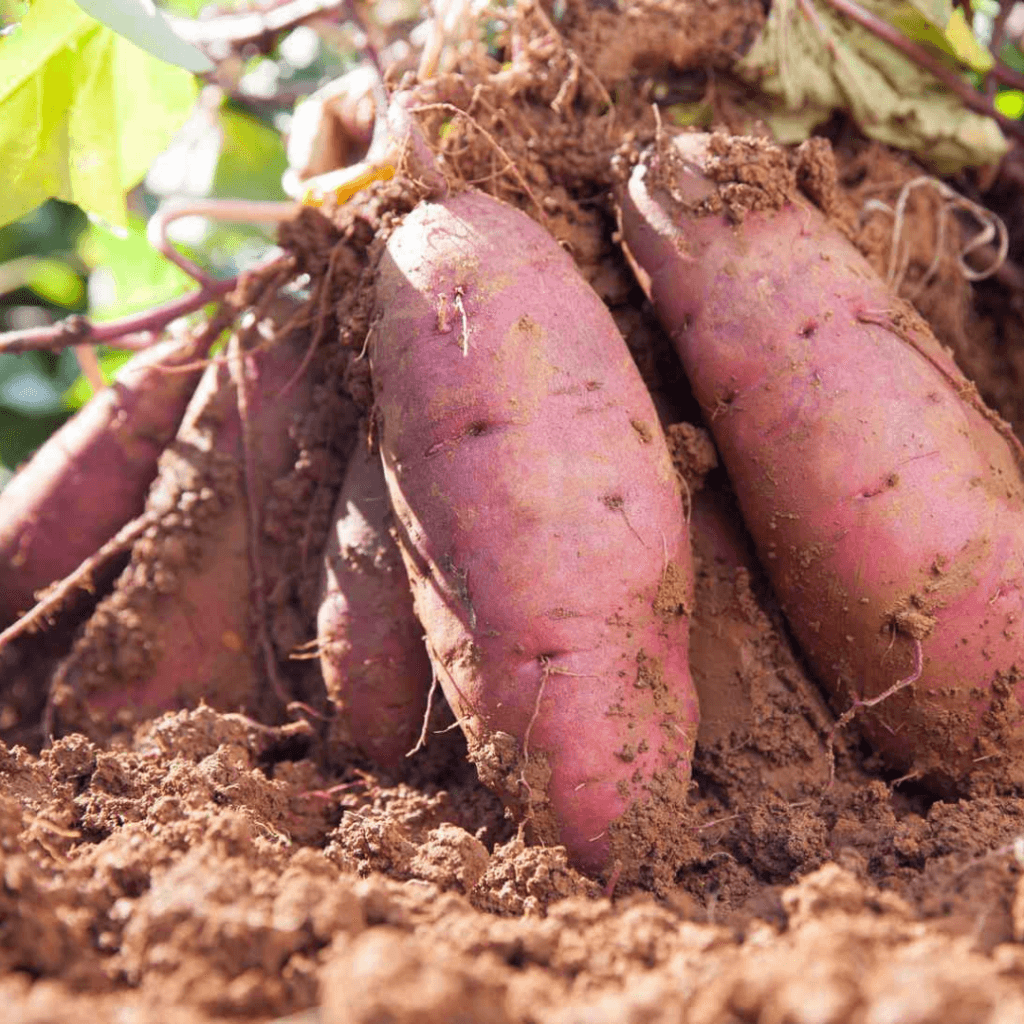Sweet Potatoes : A Full Guide for Home Gardeners with 9 steps
1. Introduction
Sweet potatoes are one of the most rewarding crops for home gardeners. With their vibrant colors, distinct flavors, and rich nutritional value, they make an excellent addition to any garden. This guide breaks down the types of sweet potatoes available, from the classic orange to the earthy white and exotic purple. You’ll also learn how to plant, care for, and harvest them successfully, especially if you’re gardening from home.
Whether you’re curious about the white sweet potato vs orange sweet potato debate or puzzled by the common confusion between red sweet potatoes, regular sweet potatoes, and yams, you’re not alone. These root vegetables often get mislabeled at markets and even in gardening circles, leading to plenty of questions. This guide is here to make everything clear. We’ll break down the visual differences, flavor profiles, and ideal uses for each type so you can choose the best sweet potatoes for your home garden and your dinner plate with confidence. No fluff, just practical, easy-to-follow insights to help you grow and enjoy the right kind of sweet potatoes for your needs.
In this article, you will discover :
2. Understanding the Basics (Category-Specific)
There are more sweet potato types than most people realize. Some have orange flesh, others are white, yellow, or purple. The shape and skin color vary too, making them easy to confuse with types of yams—though they are technically different root vegetables.
2.1. Popular Sweet Potato Varieties :
- Japeneese : Deep orange flesh, sweet, high-yielding.
- Jewel : Slightly lighter orange, great for baking.
- Hannah : White flesh with a dry texture.
- Garnet : Reddish skin and vibrant orange flesh.
- Okinawan (Purple) : Deep purple flesh, mildly sweet.
These varieties differ not only in color but in texture, flavor, and cooking uses. Orange-fleshed ones are typically moist and sweet, while white types tend to be starchier and more savory.
✅ Quick Tip : If you’re wondering how many types of sweet potatoes are there—there are over 400 globally, but only a dozen are widely available for home gardens.
2.2. Creative Ways to Use Sweet Potatoes (Cooking & More)
Once harvested, sweet potatoes offer a world of tasty possibilities. They’re incredibly versatile in the kitchen.
Popular Recipes :
- Roasted Sweet Potato Wedges : Toss with olive oil, paprika, and garlic powder.
- Sweet Potato Mash : Blend cooked sweet potatoes with butter and a dash of cinnamon.
- Sweet Potato Chips : Thinly sliced, lightly salted, and baked.
- Sweet Potato Pie : A dessert classic using orange-fleshed varieties.
- Savory Sweet Potato Hash : Combine with bell peppers, onions, and eggs.
You can also freeze them for later use or dehydrate slices for healthy snacks.
Homegrown sweet potatoes offer a fresher, richer taste than store-bought options.

3. Choosing the Right Plants (Category-Specific) :
Not every sweet potato thrives in every climate. Your zone and growing setup (ground, raised bed, or pot) will determine the best match.
Best Choices by Garden Setup :
- For containers : Hannah, Garnet, and Okinawan
- For raised beds : Japanese, Jewel, Centennial
- For sandy soils : Orleans or Georgia Jet
White Sweet Potato vs Orange Sweet Potato :
- White : Less sweet, firmer, drier—ideal for roasting and savory dishes.
- Orange : Sweeter, creamier—best for pies, mashing, and fries.
Red Sweet Potato vs Sweet Potato :
- Red is often mislabeled; usually, it refers to the skin color, like Garnet.
✅ If you’re gardening from home, opt for compact vines or varieties that do well in containers, like Japanese or Hannah types.

4. Planting Guide & Setup (Step-by-Step Instructions) :
Growing sweet potatoes starts with slips—sprouted shoots from a mature tuber. Here’s how to get started.
Step-by-Step Planting :
- Start slips indoors : Place half a sweet potato in water with toothpicks. Wait 3–4 weeks for sprouts.
- Separate and root slips : Remove shoots and place them in water until roots grow.
- Transplant outdoors : After frost risk, plant slips 12 inches apart in loose, sandy soil.
- Use containers : Minimum 5-gallon pots with good drainage for compact varieties.
✅ Soil pH should be 5.5–6.5. Add compost for better drainage and nutrition.
5. Essential Care & Maintenance :
Sweet potatoes are low-maintenance once established. Still, a little care ensures a healthy crop.
Care Tips :
- Watering : 1 inch per week; reduce before harvest.
- Sunlight : Full sun (6+ hours).
- Fertilizer : Use low-nitrogen compost or organic mix.
- Mulching : Helps retain moisture and suppress weeds.
- Vine Training : Let vines sprawl or guide along trellises.
✅ Rotate crops yearly to avoid soil-borne diseases.

6. Common Problems & Solutions (Troubleshooting Section) :
Growing sweet potatoes is easy, but pests and diseases can show up. Here’s what to watch for:
Problems & Fixes :
- Yellowing leaves : Could be overwatering or nitrogen deficiency.
- Curling leaves : Possibly aphids or whiteflies.
- Cracked tubers : Inconsistent watering.
- Rotting roots : Poor drainage or fungal disease.
✅ Natural Remedies :
- Neem oil for pests
- Compost tea for nutrient boost
- Raised beds or containers for better drainage
7. Harvesting & Maximizing Your Garden’s Potential :
Sweet potatoes mature in 90–120 days. The right harvest time and storage method make a big difference.
Harvest Tips :
- Wait until leaves start to yellow.
- Use a garden fork to avoid damaging tubers.
- Cure harvested sweet potatoes in a warm (80°F), humid place for 7–10 days.
Maximize Yield :
- Fertilize at the right time.
- Trim excessive vines to encourage root growth.
- Replant slips for a second cycle in warmer climates.
✅ One plant can yield up to 5–10 tubers with the right care.

8. Final Thoughts & Call to Action :
Growing sweet potatoes at home is rewarding, delicious, and surprisingly easy. Whether you’re drawn to the bright orange Japanese or the nutty flavor of white Hannah, there’s a type for every taste and garden.
👍 Ready to grow your own ?
Try planting two varieties this season. Share your results, subscribe to our gardening newsletter, or leave a comment below with your favorite type!
9. Conclusion :
From understanding the different sweet potato varieties to mastering every step of planting, care, and harvesting, you now have the tools to grow this versatile root crop with confidence. Whether you’re planting in a backyard garden, a raised bed, or even a balcony container, sweet potatoes are a rewarding choice for any level of gardener.
This guide has helped clarify the differences—like white sweet potato vs orange sweet potato, or the common confusion between sweet potatoes and types of yams—so you can make the right choice for your taste and growing conditions. By applying the tips shared here, you’re not just growing vegetables; you’re cultivating fresh, flavorful ingredients that can enhance your meals and your gardening satisfaction.
Remember, every harvest starts with a single slip. So grab your favorite variety, dig into the soil, and enjoy the journey of gardening from home—one sweet potato at a time. Happy growing !
10. FaQs :
- 1. How many types of sweet potatoe are there?
There are over 400 varieties of sweet potatoe grown worldwide, but about 15–20 are commonly cultivated for home gardens and cooking, including Japanese, Jewel, Garnet, and Okinawan. - 2. What is the difference between white sweet potatoe and orange sweet potatoe?
White sweet potatoe are drier and less sweet with a nutty flavor, ideal for savory dishes. Orange sweet potatoe are moist, sweeter, and perfect for baking, mashing, and desserts. - 3. Are red sweet potatoe the same as yams?
No. Red sweet potatoe (like Garnet) are true sweet potatoe. Yams are a different species entirely, usually drier, starchier, and native to Africa and Asia. In the U.S., “yam” is often used to describe orange-fleshed sweet potatoe, but it’s a mislabel. - 4. Can I grow sweet potatoe in containers?
Yesb! Use at least a 5-gallon container with good drainage. Choose compact varieties like Hannah or Japanese sweet potatoe for best results. - 5. How long do sweet potatoes take to grow?
Sweet potatoes typically take 90 to 120 days from transplanting slips to harvest, depending on the variety and growing conditions. - 6. What’s the best soil for growing sweet potatoes?
Loose, sandy, well-draining soil with a pH between 5.5 and 6.5 is ideal. Add compost to enrich the soil and improve moisture retention. - 7. When is the right time to harvest sweet potatoes?
Harvest sweet potatoes when the leaves begin to yellow, usually 3–4 months after planting. Be gentle to avoid bruising or damaging the tubers. - 8. How should I store harvested sweet potatoes?
Cure them in a warm, humid place (around 80°F) for 7–10 days to enhance flavor and shelf life. After curing, store in a cool, dry, dark location for up to 6 months.

